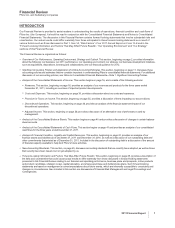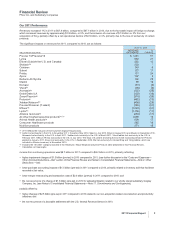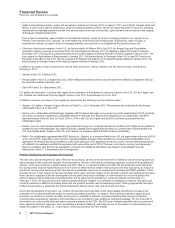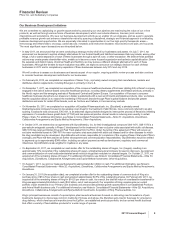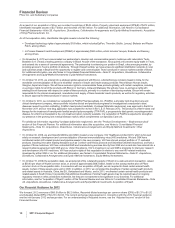Pfizer 2011 Annual Report Download - page 5
Download and view the complete annual report
Please find page 5 of the 2011 Pfizer annual report below. You can navigate through the pages in the report by either clicking on the pages listed below, or by using the keyword search tool below to find specific information within the annual report.
Financial Review
Pfizer Inc. and Subsidiary Companies
Our Operating Environment
U.S. Healthcare Legislation
Principal Provisions Affecting Us
In March 2010, the Patient Protection and Affordable Care Act, as amended by the Health Care and Education Reconciliation Act
(together, the U.S. Healthcare Legislation), was enacted in the U.S. This legislation has resulted in both current and longer-term
impacts on us, as discussed below.
Certain provisions of the U.S. Healthcare Legislation became effective in 2010 or on January 1, 2011, while other provisions will
become effective on various dates. The principal provisions affecting us provide for the following:
•an increase, from 15.1% to 23.1%, in the minimum rebate on branded prescription drugs sold to Medicaid beneficiaries (effective
January 1, 2010);
•extension of Medicaid prescription drug rebates to drugs dispensed to enrollees in certain Medicaid managed care organizations
(effective March 23, 2010);
•expansion of the types of institutions eligible for the “Section 340B discounts” for outpatient drugs provided to hospitals meeting the
qualification criteria under Section 340B of the Public Health Service Act of 1944 (effective January 1, 2010);
•discounts on branded prescription drug sales to Medicare Part D participants who are in the Medicare “coverage gap,” also known as
the “doughnut hole” (effective January 1, 2011); and
•a fee payable to the federal government (which is not deductible for U.S. income tax purposes) based on our prior-calendar-year share
relative to other companies of branded prescription drug sales to specified government programs (effective January 1, 2011, with the
total fee to be paid each year by the pharmaceutical industry increasing annually through 2018).
In addition, the U.S. Healthcare Legislation includes provisions that affect the cost of certain of our postretirement benefit plans.
Companies currently permitted to take a deduction for federal income tax purposes in an amount equal to the subsidy received from
the federal government related to their provision of prescription drug coverage to Medicare-eligible retirees will no longer be eligible
to do so effective for tax years beginning after December 31, 2012. While the loss of this deduction will not take effect until 2013,
under U.S. generally accepted accounting principles, we were required to account for the impact in the first quarter of 2010, the
period when the provision was enacted into law, through a write-off of the deferred tax asset associated with those previously
expected future income tax deductions. Other provisions of the U.S. Healthcare Legislation relating to our postretirement benefit
plans will affect the measurement of our obligations under those plans, but those impacts are not expected to be significant.
Impacts to our 2011 Results
We recorded the following amounts in 2011 as a result of the U.S. Healthcare Legislation:
•$648 million recorded as a reduction to Revenues, related to the higher, extended and expanded rebate provisions and the Medicare
“coverage gap” discount provision; and
•$248 million recorded in Selling, informational and administrative expenses, related to the fee payable to the federal government
referred to above.
Impacts to our 2010 Results
We recorded the following amounts in 2010 as a result of the U.S. Healthcare Legislation:
•$289 million recorded as a reduction to Revenues, related to the higher, extended and expanded rebate provisions; and
•approximately $270 million recorded in Provision for taxes on income, related to the write-off of the deferred tax asset associated with
the loss of the deduction, for tax years beginning after December 31, 2012, of an amount equal to the subsidy from the federal
government related to our prescription drug coverage offered to Medicare-eligible retirees. For additional information on the impact of
this write-off on our effective tax rate for 2010, see the “Provision for Taxes on Income” section of this Financial Review.
Anticipated Future Financial Impacts
We expect to record the following amounts in 2012 as a result of the U.S. Healthcare Legislation:
•approximately $500 million recorded as a reduction to Revenues, related to the higher, extended and expanded rebate provisions and
the Medicare “coverage gap” discount provision; and
•approximately $300 million recorded in Selling, informational and administrative expenses, related to the fee payable to the federal
government referred to above.
These estimated impacts on our 2012 results are reflected in our 2012 financial guidance (see the “Our Financial Guidance for
2012” section of this Financial Review for additional information).
4 2011 Financial Report


